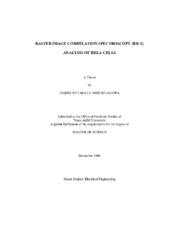| dc.contributor.advisor | Kameoka, Jun | |
| dc.creator | Sreenivasappa, Harini Bytaraya | |
| dc.date.accessioned | 2011-02-22T22:24:14Z | |
| dc.date.accessioned | 2011-02-22T23:48:07Z | |
| dc.date.available | 2011-02-22T22:24:14Z | |
| dc.date.available | 2011-02-22T23:48:07Z | |
| dc.date.created | 2009-12 | |
| dc.date.issued | 2011-02-22 | |
| dc.date.submitted | December 2009 | |
| dc.identifier.uri | https://hdl.handle.net/1969.1/ETD-TAMU-2009-12-7590 | |
| dc.description.abstract | The objective of the project is to use the RICS analysis technique in complement with
confocal microscopy to determine the diffusion coefficient of the selectively labeled
green fluorescent protein (GFP), GFP-EGFR and GFP-p53 in cervical cancer cells. This
is a collaboration work with MD Anderson Cancer Center. The application of the study
is to lay the foundation for further study in understanding the cell metabolism, subcellular
morphologic and dynamic biochemical processes to aid in the diagnosis and to
potentially screen cancers.
Fluorescence microscopy techniques have been developed for the study of cellular
processes and molecular signal pathway. However, the spatial resolution to distinguish
and resolve the interactions of single molecular complexes or molecule in cells is limited
by the wavelength. Hence, indirect image correlation methods complementary to the
imaging techniques were developed to obtain the dynamic information within the cell.
RICS is one such mathematical image processing method to determine the dynamics of
the cell.
HeLa cells are transfected with GFP to highlight the protein of interest. These samples
were imaged with confocal microscope, Olympus FV1000 with a 60 x 1.2 NA water
objective in the pseudo photon counting mode with an excitation of 488 nm argon ion
laser. About 100 frames of scan area 256x256 pixels were collected from each sample at
scan speed of 12.5 seconds per pixel. The stacks of images were processed with SimFCS
software. The images were subjected to immobile subtraction algorithm to remove the
immobile features. Consequently, each frame in the stack is subjected to 2D-correlation;
then, the average 2D-spatial correlation is calculated. This 2D-spatial correlated data
constitutes as RICS data which is then displayed and analyzed by fitting it to specific
models. This generates a spatial temporal map of the molecular dynamics of
fluorescently labeled probes within the cell.
In summary, we apply RICS techniques based on correlation spectroscopy to the image
data and quantify diffusion coefficient of protein of interest in cancerous cells with
different treatments. This is expected to better understand cellular dynamics of
cancerous cells and build better diagnostic biosensor devices for early screening. | en |
| dc.format.mimetype | application/pdf | |
| dc.language.iso | en_US | |
| dc.subject | HeLa cells | en |
| dc.subject | p53 | en |
| dc.subject | RICS | en |
| dc.title | Raster Image Correlation Spectroscopy [RICS] Analysis of HeLa cells | en |
| dc.type | Book | en |
| dc.type | Thesis | en |
| thesis.degree.department | Electrical and Computer Engineering | en |
| thesis.degree.discipline | Electrical Engineering | en |
| thesis.degree.grantor | Texas A&M University | en |
| thesis.degree.name | Master of Science | en |
| thesis.degree.level | Masters | en |
| dc.contributor.committeeMember | Su, Chin | |
| dc.contributor.committeeMember | Cheng, Xing | |
| dc.contributor.committeeMember | Chang, Kuang-An | |
| dc.type.genre | Electronic Thesis | en |
| dc.type.material | text | en |


